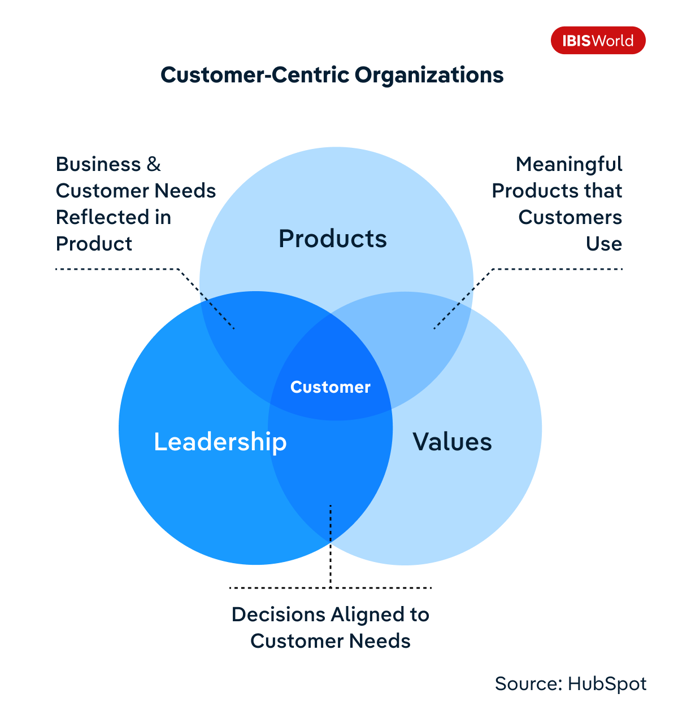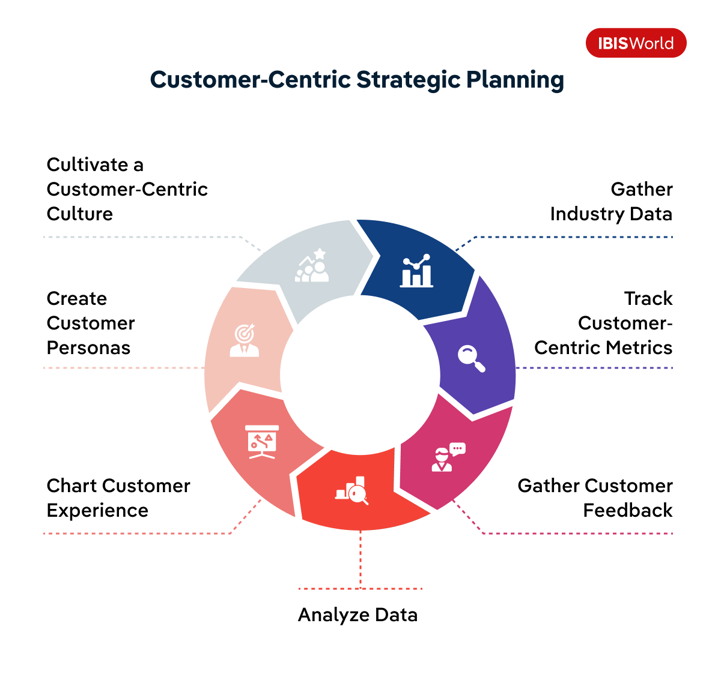In order for salespeople to truly engage, build value, and develop long-lasting relationships, they must compliment their selling approach with sales enablement tools and technology. Listening with the intent to learn, asking questions that are not product-based, and understanding the nuances, trends, and challenges of a company and industry are required in today’s environment. We turn to a valued resource and partner IBISWorld for more on this topic:
From Listening to Leading. Customer-Centric Strategic Planning
From Diana Jennings, Director of Global Experiences at IBISWorld
When I first started in a client-facing role, I received a piece of advice that has stuck with me ever since: “Listen more than you speak.”
While it is important to enter client conversations with a clear plan to add value, you must also bring a willingness to truly listen. By occasionally setting aside my own agenda, I found it easier to understand the customer’s real needs. Although I’m no longer on the phone with customers daily, I still believe that listening to your customers is critical to any business function, particularly strategic planning.
Being a customer-first organization is not just a catchy slogan, it's a strategic imperative. At its core, customer-centric strategic planning means aligning your business's goals, products and services with your customers’ evolving needs and expectations. Yet customer centricity goes beyond just implementing their feedback – it’s about deeply understanding their pain points, preferences and aspirations, and using that knowledge to drive every decision you make.
Over the years, customer centricity has evolved from a buzzword to a fundamental part of strategic planning. Initially, it was about addressing customer complaints and providing good service. These days, it has morphed into a comprehensive approach that shapes entire business models and drives innovation. However, this shift hasn’t been without its challenges. Some companies still struggle to integrate genuine customer feedback into their strategies, often focusing too much on internal processes or short-term gains.
The key to successful strategic planning lies in achieving synergy between industry research and customer insights. By combining these two sources of information, businesses can develop a more holistic view of their industry and customers, leading to more informed decisions and better outcomes.
What is customer centricity?
A customer-centric business approach prioritizes customers’ needs and preferences at every stage of their interaction with the company and within the business’s internal processes. It means designing products and experiences that aim to not only meet but also exceed customer expectations.
The purpose of customer centricity is to build long-term relationships that foster loyalty and advocacy. When customers feel valued and understood, they’re more likely to stick around, recommend your products or services and contribute to your business’s growth.
Some of the most successful businesses in recent years are known for taking a customer-centric approach, resulting in a loyal customer base, high customer satisfaction, a competitive edge and, ultimately, revenue growth. However, a key aspect of customer centricity is continuous listening. Customer expectations can change swiftly, making it critical to consistently monitor satisfaction metrics and be prepared to pivot when needed.
How to center the customer in business strategy
Creating a customer-centric strategy involves understanding both macro trends across your business’s industry and direct customer feedback. By combining this data, businesses can develop products, services and experiences that truly resonate with their customers. Here is how to effectively use industry research and customer feedback to create a customer-centric strategy:
Gather industry data
Begin with a thorough analysis of the industry and market landscape. Starting at this macro level helps to understand the broader trends and competitive dynamics within your industry and adjacent industries up and down the supply chain. Is there a product or service with a growing or declining market size? Does that growth or decline present an opportunity or risk to your business? What are the most successful companies in your space doing? This industry-level research will provide the context needed to frame your customer-centric strategies effectively.
Start tracking customer-centric metrics
Every business leader has their own set of performance metrics at the forefront of their minds when they consider long-term strategic plans. However, there are foundational customer satisfaction metrics that every business should monitor to effectively measure their customers' sentiment.
These include Net Promoter Scores (NPSs), Customer Satisfaction Scores and, if applicable, customer retention or renewal rate. Having a read on metrics like NPS and monitoring fluctuations in these scores can provide early indicators of any underlying problems across your customer base that warrant further investigation.
Gather customer feedback
Depending on what stage your business is at, this step will likely require the most effort. Start by conducting interviews with new, existing and former customers and run quantitative surveys to gauge their experience with your organization, your organization’s support network and, of course, your product or service itself.
Structuring your customer interviews to be more open-ended typically returns the best results, so listen actively and document their needs, pain points and suggestions. You can combine these qualitative interviews with more structured surveys to collect feedback from more customers.
Analyze the data
Gather all the available data you have on your customers, including satisfaction metrics, qualitative and quantitative feedback and any other customer data you may have. Depending on your business, this could include support desk tickets, usage trends, user behavior trends and revenue performance metrics like renewal and churn rates.
Once you have aggregated all your data, you’ll be able to leverage data analytics to gain deeper insights into customer behavior and preferences. Use this data to identify patterns, trends and correlations that can inform your strategy.
Chart the customer experience
Begin by mapping out your business’s customer journey stages and the key touchpoints within it. By identifying how customers interact with your organization, from their initial discovery to purchasing, using and retaining your product or service, you can demystify the journey and shed light on how customers really engage with your business to determine potential pain points.
Understanding where customers encounter the most friction allows you to address these issues effectively. For instance, if you’ve identified that prospective customers struggle to discover and learn about your offerings, it’s time to involve sales and marketing. On the other hand, if customers use your product once but don’t become repeat users, it might indicate a gap in product-market fit or the support they receive from customer success teams. As a strategic leader, assigning ownership to these problems ensures they’re tackled head-on, paving the way for a truly customer-centric approach.
Create customer personas
Develop detailed customer personas to represent the distinct segments of your customer base. Creating these personas will allow you to identify each group’s specific needs and preferences so you can tailor your strategies effectively. These personas should include firmographic data, their goals when using your product or service, typical behaviors, pain points and challenges they face.
Once you’ve developed these personas, you can start segmenting your customer data and satisfaction metrics to help your teams prioritize where to focus. Is your NPS dropping for one persona specifically? Are you overserving or underserving one persona in a particular touchpoint across the customer journey? Having these personas mapped out will provide a comprehensive understanding of your customers that you can consistently reference when building products or enhancements and prioritizing long-term strategies.
Cultivate a culture of customer centricity
This stage is about fostering a customer-centric culture at your organization, and the first step to that is communicating what your customers are feeling and why with stakeholders across your business to help them stay connected to customer needs. The customer must be considered in all areas of your business and at every level to really achieve customer centricity, not just within your client services and customer experience teams! Product, marketing, operations and even developer teams must be connected to customer problems and understand what’s important to your user base to make decisions centered on the customer.
The most successful companies do this by establishing a brand promise or even a set of principles that serves as a commitment to what their customers can expect when they interact with the company and, ultimately, the experience they’ll receive. Your brand promise should be based on what’s most important to your customers and can serve as the north star that internal teams and stakeholders look to when making decisions.
Embed the customer as a pillar of your strategy
To truly keep the customer at the heart of your business strategy, it’s essential to make customer insights a cornerstone of your planning and prioritization process. This means constantly reviewing feedback and making strategic decisions around product development, marketing, sales and customer support priorities with these findings in mind.
A key aspect of this is ensuring it’s a continuous, dynamic process. Establish regular review cycles where your teams assess the latest customer feedback and industry trends to adjust your strategies accordingly. Establishing an ongoing process ensures your strategies remain aligned with evolving customer needs and preferences. This approach not only keeps your business focused on its customers, but also positions you to anticipate and meet customer needs proactively, driving long-term success.
Common obstacles and how to overcome them
Implementing a customer-centric strategy can be challenging. By understanding and addressing these common obstacles, businesses can navigate the process more effectively and ensure a smoother transition to a customer-centric approach.
Siloed Departments
Break down silos by implementing regular meetings and shared goals that emphasize customer-centric outcomes and foster cross-departmental collaboration. Encourage knowledge sharing and ensure that customer insights are accessible to all departments, not just customer-facing staff.
Resistance to Change
Address resistance by clearly communicating the benefits of a customer-centric approach and providing training and resources to help employees understand and embrace new processes. Highlighting success stories and quick wins will build momentum and demonstrate the value of customer centricity to those that’re still unsure.
Data Overload
Implement advanced analytics tools to sift through large volumes of data and extract meaningful insights. Focus on key metrics that directly impact customer satisfaction and business performance to simplify data reporting and make it accessible and actionable for all stakeholders.
Limited Resources
Prioritize customer-centric initiatives that offer the largest impact while leveraging technology and automation to optimize resource allocation. Collaborate with external partners or consultants to gain expertise and scale efforts efficiently without overburdening internal teams.
Final thoughts
The journey toward true customer centricity is continuous. It demands constant monitoring, evaluation and iteration. However, the rewards – loyal customers, sustainable growth and a competitive edge – make it a journey worth undertaking. By combining industry research with customer insights, businesses can create strategies that are not only effective but also resilient in the face of change.
Next time you find yourself in a meeting discussing long-term priorities or your business's strategic goals, strive to be the voice in the room advocating for your customer. Are we considering the customer here? Does this plan align with our customers' expectations? If we can all commit to making the customer the guiding star of our strategic plans, we’ll remain agile, relevant and dedicated to exceeding their expectations.
Source: https://www.ibisworld.com/blog/customer-centric-strategic-planning/99/1127/





